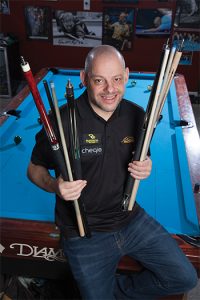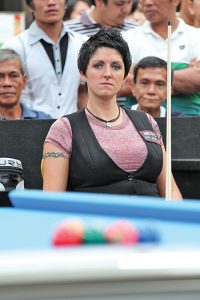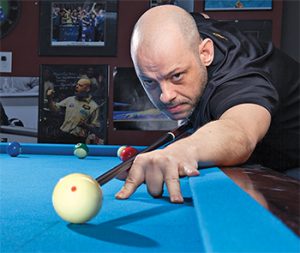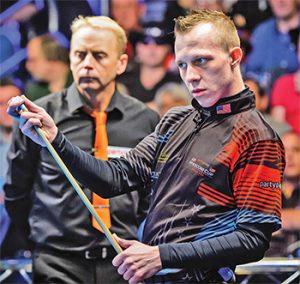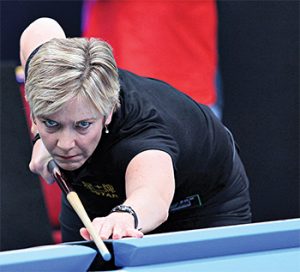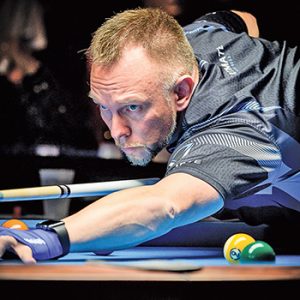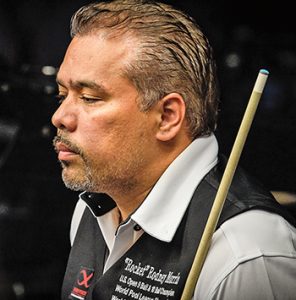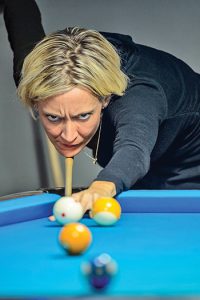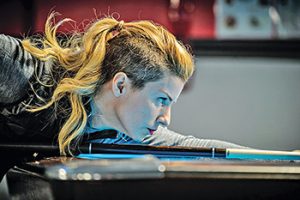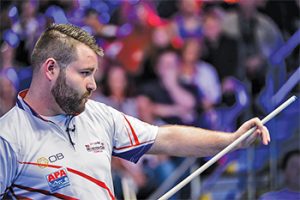IPT World Open Preview: Talented Tots Wu and Ouschan to Debut
The big news in the first round of the International Pool Tour’s latest multi-million dollar 8-ball tournament will be the debuts of young superstars Chia-Ching Wu of Taiwan and Jasmin Ouschan of Austria, both looking for a big piece of the record-setting $3 million purse.
The eight-day 8-ball event — with a precedent-setting $500,000 first-place prize — kicks off Sunday, Sept. 3, at the Grand Sierra Resort and Casino in Reno, Nev.
Both 17-year-old Wu and 20-year-old Ouschan earned entry into the tournament through the IPT’s rugged qualifier process, and they’re expected to go deep. The precocious Wu is the current WPA world 9-ball and 8-ball champion, and Ouschan topped the star-studded field at the EnjoyPool.com 9-Ball Championship in May.
Otherwise, it looks like smooth sailing for most of the favorites in the first round of the International Pool Tour’s World 8-Ball Open Championship, as the just-released groupings reveal predominantly balanced matchups for the first two days of the event. Top-ranked players were seeded in the field.
Of course, a few players had cause for muttering under their breaths when the groups were announced early Friday. Of the best-known players, Hall-of-Famers and best buddies Ewa Laurance and Loree Jon Jones appear to have their work cut out for them. For that matter, the groupings did no favors for Ouschan, the only female player to have won a spot in an IPT field through the qualifier process.
Expect some surprises. As the players learned in the IPT’s first event of the 2006 season — the North American Open 8-Ball Championship in July — there are dozens of unheralded 8-ball whizzes out there waiting for their big shot, and the 200-player World field features 50 qualifiers who have already proved their mettle.
Look for surprising runs from several Asian qualifiers who now have their feet in the IPT’s door, including Wu from Taiwan (who was seeded 16th in the absence of Filipino Rodolfo Luat), and his countryman Hui-Kai Hsia, a two-time world juniors champion.
The first round will feature 40 groups of five players each. After round-robin play, the top three finishers in each group will proceed to the second round. Eliminated players from the first round will each receive a whopping $5,000.
The complete list of groupings is available at the IPT Web site: www.internationalpooltour.com.
Here are some of the more intriguing brackets from the first round:
Bracket 23 — BD Bloodbath Special: Spectators looking for an exciting bracket to follow should check out this group. No superstars, just tough and hungry veterans: Ivica Putnik (Croatia), Thomas Engert (Germany), Tony Chohan (USA), Tony Drago (Malta), and Zlatko Jakulj (Croatia)
Bracket 1: German sensation Thorsten Hohmann received the top seed by virtue of his $350,000 win at the North American Open, joined here by talented American Steve Moore, Filipino toughie Warren Kiamco, and Americans Jim Raney and Loree Jon Jones. Jones, who survived the first round at the North American Open, will have to bring her “A” game here.
Bracket 26: Austria’s Jasmin Ouschan must contend with Hall-of-Famer Earl Strickland, Swedish veteran Tom Storm, Aruba national champion Roland Acosta and American Pete Fusco. Ouschan regularly hones her skills against the best male players in Europe, so don’t expect her to be intimidated by Strickland, or anyone else in the field, for that matter,
Bracket 18: Hall-of-Famer Ewa Laurance will have her hands full with Australia’s Quinten Hann, the snooker bad boy who finished a surprising 18th at the North American Open; snooker ace Ronnie O’Sullivan from the U.K.; and Jeremy Jones (USA) and Jose Parica (Philippines), both experienced champions who met untimely exits at the North American Open. This bracket will be a dog fight.
Bracket 35: Future Hall-of-Famer Allison Fisher, who was undefeated in the first round of the North American Open, once again has a clean look at the second round. But watch out for qualifier Hui-Kai Hsia of Taiwan and surprising Frenchman Yannick Beaufils. Tough Americans Teddy Garrahan and John Ditoro round out the group, and neither will play patsy.
Bracket 10: Once again, 13-year-old Austin Murphy has a good shot at leaving the first round, this time sharing a bracket with 10th-ranked Darren Appleton (U.K.), Paul Potier (Canada), George San Souci (USA) and Ouahbi Amine (Morocco). Murphy missed the second round at the North American Open by a single rack, losing an 8-7 nailbiter to Danny Basavich. Let’s go, Austin.
Corr Pulls Ahead of the Pack
Karen Corr is on a roll. Last month at the Florida Classic, she knocked off Allison Fisher in the final, and this month, at the Midwest Classic, she defeated the other Fisher, Kelly, in a final that tested the bladder control of many an audience member. With three titles so far in the 2006 season, Corr has left both Fishers, who have a title apiece, in the dust for the Player of the Year race.
Nine of the tour’s top players competed in the International Pool Tour’s North American Open just days before the Midwest Classic commenced at the Par-a-dice Hotel and Casino in Peoria, Ill. Sarah Ellerby went the farthest in the 8-ball event, and had to fly overnight from Vegas to make it in time for her first match in the Midwest.
While an exhausted Ellerby was knocked out early, the rest of the IPT members didn’t seem affected by the transition from 8-ball to 9-ball. After three rounds, eight players remained undefeated: Corr, Monica Webb, Kim White, Kelly Fisher, Allison Fisher, Jeanette Lee, Xiao-Ting Pan, and Belinda Calhoun.
The remaining players battled it out in the one-loss side to reach the top 16. The bottom eight were Sarah Rousey, Val Finnie, Julie Kelly, Ga-Young Kim, Ewa Laurance, Megan Minerich, Gerda Hofstatter and Pam Treadway.
In the single-elimination matches to determine the semifinalists, Allison Fisher was knocked out by Chinese up-and-comer Xiao-Ting Pan. She, along with Webb, Corr, and Kelly Fisher advanced.
Both semifinal matches were decided by crucial plays at 4-4. Kelly Fisher outplayed Pan in the semifinal, 7-4, after the tiny 24-year-old fouled on a jump shot. Fisher said that revenge was sweet, as Pan had knocked her out in San Diego. Corr also won 7-4, pulling ahead against Webb after an untimely scratch.
In the final between Fisher and Corr, the game of 9-ball had never so resembled ping-pong. The former snooker players battled back and forth, going 2-2, 3-3, 4-4, and 5-5 after Corr jarred an easy 9 ball. With a race-to-2 determing a difference in payouts of $5,000, Corr ran out to reach the hill. Fisher broke in the case game, and executed a safety. Corr mulled over the shot, and ended up scratching. Fisher sank the 2 and played safe on the 3, which Corr pocketed with a surprising two-rail bank shot, which proved to be the winning shot. She ran out the rest of the rack for the $13,000, and her third title of the season.
Check out www.wpba.com for the full bracket and photo highlights.
IPT Round Three Complete
LAS VEGAS, Nev. – Despite some strong opposition from European players, including the surprising contingent of English 8-ballers, the always tough Filipinos are dominating the history-making IPT North American 8-Ball Open.
Virtually every Filipino competitor who started in the 200-player field has made it through to the 36-man fourth round of play – nine altogether, including three Pinoy hopefuls who needed to win qualifiers to gain entry to the $2 million tournament.
Leading the pack, as usual, was legendary Efren “Bata” Reyes, whose overall record stood at 12-1 after three days of round-robin play. No less impressive was the ball-control mastery of Filipino Marlon Manalo, who held an identical 12-1 record, along with Germany’s Ralf Souquet and Rafael Martinez of Mexico.
Third-round play began on Wednesday at the Venetian Hotel and Casino with the remaining 60 players divied into 12 groups of five. The top three in each group would advance to the fourth round on Thursday with a guarantee of at least $17,000 in prize money; the eliminated players would collect a still-impressive $10,000 each.
By 9:45 p.m., the lucky 36 were known. Their names follow, grouped by country, with their third-round records:
USA: Dee Adkins, 4-0; Jason Kirkwood, 3-1; Earl Strickland, 3-1; Cory Deuel, 4-0; Shawn Putnam, 3-1; Rodney Morris, 3-1; Larry Nevel, 3-1; Gabe Owen, 2-2; and David Matlock, 2-2.
Philippines: Efren Reyes, 4-0; Marlon Manalo, 4-0; Francisco Bustamante, 2-2; Dennis Orcollo, 3-1; Antonio Lining, 4-0; Rodolfo Luat, 2-2; Alex Pagulayan, 3-1; Santos Sambajon, 2-2; and Ronato Alcano, 2-2.
United Kingdom: Rico Diks, 2-2; Raj Hundal, 1-3; Daryl Peach, 2-2; Darren Appleton, 2-2; Mick Hill, 3-1.
Netherlands: Niels Feijen, 3-1; Alex Lely, 3-1; and Nick Van den Berg, 3-1.
Germany: Ralf Souquet, 4-0; and Thorsten Hohmann, 3-1.
Other countries: Quinten Hann (Australia), 2-2; Ivica Putnik (Croatia), 2-2; Mika Immonen (Finland), 3-1; Sandor Tot (Italy), 2-2; Yannick Beaufils (France), 2-2; Rafael Martinez (Mexico), 4-0; Evgeny Stalev (Russia), 2-2; and Marcus Chamat (Sweden), 3-1.
Here are some highlights from the round:
* The biggest eye-opener for many established players at the Open has been the success of the top competitors on the English 8-ball circuit, including perennial champions Mick Hill and Darren Appleton. Both will compete in the round-of-36.
“Us lads have come to play the top players from around the world, and I feel that we haven’t been given a chance,” said 26-year-old Hill. “The point that us English lads want to get across to everyone, including our own back home, is that we’re playing 8-ball, not 9-ball or straight-pool. … A lot of people don’t realize that the English players play 8-ball.”
Among their strengths are excellent cue ball control and solid stroke mechanics, said observers.
“Those guys shoot very straight, and I can respect that,” said IPT member Ike Runnels.
* Fifteen women started the competition on Sunday, and only former snooker stars Allison Fisher and Karen Corr were given much of a chance to advance. One woman was able to infiltrate the third round, and she was a U.K. native, but no one you might expect.
“I sort of in a way proved a point,” said Sarah Ellerby, who collected dozens of 8-ball titles in England before coming to the U.S. to compete on the WPBA Classic Tour. “…There wasn’t as much attention on me as on the other girls, and that’s fine.
“I’m sure that some of the guys were like, ‘The women won’t do well here,’” Ellerby said. “If I could break better, I feel like I could really make more of a dent. I think the women are capable enough to come here and do well.”
Unfortunately, Ellerby fell into a tough bracket in the third round and finished with a 1-3 record. Knowing she wouldn’t advance, Ellerby immediately left for the Las Vegas airport to catch an 11:30 p.m. United Airlines flight to Chicago. There, she would catch a limo for a two-hour drive to Peoria, the site of the WPBA Midwest Classic, which was starting play Thursday morning.
“I’m going to be very tired,” she said.
* Staying on the English for another moment, sharp observers might note that Raj Hundal advanced with a 1-3 record. It’s no misprint. Hundal was in a bracket with players who posted 4-0 and 3-1 records (Reyes and Strickland), leaving the other three players with 1-3 tallies. Of the three, Hundal had the highest games-won percentage (56.49 percent, just over American Gary Abood’s 55.09 percent), which pushed him into the next round. That 1.4 percent difference was worth at least $7,000.
“I’m in! I’m in!” the burly Hundal screamed upon hearing the results. “I’m freewheeling tomorrow! … I’m the luckiest [expletive] in the world!”
* Another surprise at the end of the day was how many players who were forced to qualify for the event ended up in the round-of-36. The 200-player field offered 50 qualifiers, and no fewer than nine made it into the fourth round. They included Filipinos Luat, Sambajon and Alcano.
* Most of the favorites remained in the running for the fourth round, with one major exception. American Johnny Archer faded in his bracket, finishing with a 1-3 record.
IPT Round Three: The Plot Thickens as the Field Thins
Round three starts today in the International Pool Tour’s North American Open and already 17,066 games have been played. Fatigue certainly played a role yesterday with 120 players facing a $5,000 difference in payout as they were whittled down to 60 in 12 straight hours of 8-ball action. The 60 remaining contenders who advanced to round three have been placed into 12 groups of five players each. Three players from each group will advance to the next round. The 24 who are eliminated will receive a lovely parting gift of $10,000.
Here’s a breakdown of yesterday’s highlights:
Mike Sigel was eliminated with a 2-3 record after losses to Marlon Manalo, Marko Lohtander and Quinten Hann. “The Mouth” settled for 61st and a $5,000 consolation prize.
The female players are near extinction, survived only by Sarah Ellerby who edged out Corey Harper by less than one percentage point in win average to advance to round three. Both Loree Jon Jones and Allison Fisher went winless in round two, and Gerda Hofstatter was eliminated with only one win.
Only eight players went undefeated throughout yesterday’s round, including three Americans: David Matlock, Nick Varner, and Charlie Williams. Also unscathed: Australian Quinten Hann, Filipino Santos Sambajon, Mexican Rafael Martinez, Mika Immonen of Finland, and Ivica Putnik of Croatia.
The Filipino contingent is now down three men, with Warren Kiamco and Gandy Valle eliminated after round two, and Jose Parica eliminated after round one. Still, 10 of the original 13 remain and most dominated their groups. Francisco Bustamante fell to Efren Reyes, but has the highest winning percentage of the entire field at 73.68 percent. (Johnny Archer is second with 70 percent.)
Snooker superstar Ronnie O’Sullivan held on by the skin of his teeth, with only two wins, but advanced on the merit of his winning percentage. On the other hand, Takeshi Okumura missed out on advancing by 0.03 percent to Larry Nevel.
Veterans Allen Hopkins, Kim Davenport, Keith McCready are all heading home. George San Souci and Tony Chohan went winless in round two. Other notables who are heading home with $5,000 consolation prizes: Danny Basavich, Jeremy Jones, George Breedlove and Oliver Ortmann.
Round three is upon us, and each player will play five matches among formidable fields. Here’s a quick analysis:
Ellerby will have to face two top Americans: Gabe Owen and Charlie Williams and two Filipinos: Marlon Manolo and Ronato Alcano. Good luck!
Earl Strickland is alive and well in the tournament, but grouped with Raj Hundal and Efren Reyes, the recently inducted Hall-of-Famer will have to fight hard to see another day.
German Thorsten Hohmann is by far the biggest name in his group, but will face Mick Hill, a promising British 8-baller.
Check out this group: Break-and-run Bustamante, Undefeated Ozzy Quinten Hann, 8-Ball Boy Wonder Karl Boyes, Prince of Pool Cory Deuel, and Bad Boy O’Sullivan. Yikes!
Mika Immonen and John Schmidt will face off in their group — undoubtedly there will be some good-looking pool played there.
IPT Open Continues: Filipinos Dominate; Fisher’s Perfect While Most Women Falter
The IPT’s North American 8-Ball Open is shaping up to be the Philippines 8-Ball Smackdown.
The Filipino contingent flew their flag high and often on Monday — the second day of the history-making, $2 million event — as six Pinoy shooters scored perfect 4-0 records in round-robin play: Efren Reyes, Alex Pagulayan, Francisco Bustamante, Marlon Manalo, Dennis Orcollo and Ronato Alcano.
Joining the ranks of the undefeated was Brit snooker and 9-ball superstar Allison Fisher, who steamed through a fairly soft bracket to qualify for the next round of play. However, she was one of only two women of the 15 female tour members to score a winning record, and one of only four to advance. The U.K.’s Sarah Ellerby had the other winning record, 3-1.
Top female pros making early exits Monday included Ireland’s Karen Corr, who went 1-3 in a particularly tough draw; the U.K.’s Kelly Fisher, 1-3; Helena Thornfeldt of Sweden, 0-4; and American Monica Webb, 0-4.
Play on Monday centered on the second set of 100 competitors in the 200-player field, divied up into 20 groups of five. The top three in each group advanced to today’s round, featuring the remaining 120 players, parsed into 20 groups of six.
The 80 eliminated players from the first round will settle for $2,000 each. The winner of the event will pocket a record $350,000.
Here’s a brief wrap-up of Monday’s highlights:
• One of the biggest surprises of the Open so far is the number of players who qualified for the event — those not among the 150 regular IPT tour members — who are posting undefeated records. These surprise contenders from Monday’s play include Dutchman Rico Diks; England’s Karl Boyes; and Anthony Ginn of Australia.
• Keith Bennett, a 27-year-old house pro at Breaktime Billiards in Wilmington, N.C., who made it into the Open as alternate after Hall-of-Famer Jim Rempe bowed out, posted a 4-0 record in the first-round on Monday.
• The four women to advance to Tuesday’s matches in the round-of-120 were Allison Fisher, 4-0; the U.K.’s Sarah Ellerby, 3-1; Hall-of-Famer Loree Jon Jones (U.S.), 2-2; and Austria’s Gerda Hofstatter, who managed to limp into the next round with a 1-3 record when her games-won percentage topped two other players in her group with the same record (Ed Kelly and Jim Weast, both of the U.S.; Hofstatter’s games-won percentage was in fact just 1 percent higher than Weast’s).
• Beyond the Filipinos, who were expected to do well, several favorites sent messages to the field that they were not to be underestimated. Also posting 4-0 records were well-regarded Americans Johnny Archer and Shannon Daulton, and Germany’s Oliver Ortmann.
“Yikes!” or “Whew…”: IPT North American Groupings Announced
“Yikes!” or “Whew…”: IPT North American Groupings Announced
Jul 14, 2006, 9:44 AM
Several top pool pros won’t be sleeping too soundly for the next week, now that they know the identities of their opponents in the first round of the International Pool Tour’s North American 8-Ball Open Championship.
Among those who might have trouble catching some “zees” are Karen Corr, Cory Deuel, Charles “Hillbilly” Bryant, and Kim Davenport. On the other hand, Allison Fisher and 13-year-old Austin Murphy look to be pretty well rested.
The $2 million, 200-player event — with a $350,000 first-place prize — kicks off Sunday, July 23, at the Venetian in Las Vegas, Nev.
The IPT announced the first-round groupings — composed of 40 sets of five players each — on Thursday. After round-robin play, the top three finishers in each group will proceed to the next round. Eliminated players from the first round will each receive $2,000.
The complete list of groupings is available at the IPT Web site: www.internationalpooltour.com.
However, we’ll point out a few of the more remarkable first-round matchups to get the inevitable debate and buzz started. In no particular order:
Group 20 — International Incident
A big-time pro is going home with $2,000 — and the lonely, agonizing plane ride could be transcontinental. The round’s toughest group is topped by former world 9-ball champions Mika Immonen (Finland) and Oliver Ortmann (Germany). They’re closely followed by tough-as-nails American Charles “Hillbilly” Bryant and the wily Gandy Valle from the Philippines. If “Gentleman” Jim Raney (USA) can make it out of this group, he deserves a $10,000 bonus.
Group 14 — Cakewalk
It’s dangerous to call any group a “gimme,” because there are so many relatively unknown international players in the IPT. You can bet there will be several surprises along the way. But Brit snooker and 9-ball ace Allison Fisher looks like a lock to get past group 14, populated by middling and/or obscure players Grady Matthews (USA), Andreja Klasovic (Serbia/Montenegro), Marko Lohtander (Finland), and Jeff Abernathy (USA).
Group 32 — Dogfight of the Sleepers
Fans might not know all these names, but one or two of these guys are sure to be around late in the event. The group features rough road player Steve Moore (USA), 2006 Derby City Master of the Table winner Jason Miller (USA), resurgent 9-ball pro Kim Davenport (USA), and Canadian aces Paul Potier and Tyler Edey.
Group 18 — Bloodbath
A top player is going to go down here. This one looks like the semifinals roster from a Reno Open, with multitalented Shannon Daulton (USA) facing off against Canadian stalwart (and, coincidentally, 2005 Reno Open winner) Ronnie Wiseman, former BD Player of the Year Cory Deuel (USA), Chicago 8-ball machine Ike Runnels, and sneaky veteran Pete Fusco (USA).
Group 2 — No Rest for the Invader
Ireland’s Karen Corr will have her work cut out for her against Holland’s top pro Niels Feijen, China’s no-nonsense Wei-Liu, underrated 8-baller Greg Hogue (USA) and Hall-of-Famer Ray Martin. But Corr went 4-1 in the first round of December’s IPT King of the Hill event, so look for her to pass with honors.
Group 5 — Let’s go, Austin!
Okay, we’re (unofficially) rooting for 13-year-old Austin Murphy, who is no slouch, by the way. He just won his second consecutive title at the BCA Junior Nationals, and he can hold his own against the big guys. He has an excellent chance to get out of his first-round group, where he will face Danny Basavich (USA), Hall-of-Famer Ewa Laurance (USA), and little-known qualifiers Sam Monday (USA) and Anthony Ginn (England).
WPBA Florida Classic Starts Tomorrow
The Women’s Professional Billiard Association’s fourth stop on the Classic Tour, the Cuetec Cues Florida Open, begins tomorrow, June 29, at the Hard Rock Hotel and Casino in Hollywood, Fla.
Last year No. 2-ranked Karen Corr defeated No. 1-ranked Allison Fisher, as well as Monica Webb and Ga-Young Kim to win her first title in 2005. Check out http://www.wpba.com/, which will have regular result updates, to see if she can defend her title.
Ouschan Upsets Fisher; Souquet Gives Archer Second Second-place Finish
Jasmin Ouschan, who has become known as the “Ice Princess” for her arctic facial expression during competition, couldn’t help but crack the no-nonsense mask, revealing a stunning smile after ousting the undefeated defending champion Allison Fisher, 7-5, in the 2006 Enjoypool.com 9-ball Championship final, held May 20 at the Riviera Hotel and Casino in Las Vegas, Nev.
Ouschan joined German Ralf Souquet in the winner’s circle after Souquet gave Johnny Archer his second second-place finish at the event, 7-5, after a 7-0 whitewashing by Thorsten Hohmann last year. Both victors worked hard for the $20,000 payout, battling back from the one-loss side, where they had to overcome some stringent competition.
Just 20 years old, Ouschan is an Austrian native who came onto the U.S. women’s pool scene four years ago. Ouschan made waves early on in the tournament, knocking two-time World Champion Ga-Young Kim to the losers’ side in the first round. She had a mettle-testing road to the finals after Melissa Herndon knocked her down to the one-loss side in the third round. She beat the likes of Dawn Hopkins, 9-8, Karen Corr, 9-7, Kelly Fisher, 9-3, Pam Treadway, 9-3, fellow Austrian Gerda Hofstatter, 9-3, and Shin-Mei Lui, 9-2, to meet Helena Thornfeldt in the semifinal, who she defeated, 7-6.
In the final Ouschan faced the favorite Allison Fisher, who remained unscathed through the winners’ side. Fisher was flawless early in the match, jumping out to a 3-0 lead. Ouschan then came back and won 3 games of her own to tie the match at 3-3. The match was tied again at 4-4, but Ouschan won two in a row to get to the hill at 6-4. From there, they split racks on their breaks and Ouschan won, 7-5.
After making it to the fifth round by beating the revered Efren Reyes, 11-8, Souquet was knocked to the one-loss side by Archer, 11-8, where he had to face Reyes again. He came out on top once again to redeem himself against Archer in the final, 7-5.
Both Archer and Fisher took home $10,000 for their efforts.
Enjoypool.com 9-Ball Championships Underway
Pool heavyweights and hopefuls alike arrived in Las Vegas over the weekend to compete in the Enjoypool.com 9-Ball Championships, which got underway May 14, at the Riviera Hotel and Casino.
This event always draws the top fields from both the men’s and women’s games, and this year is no different. Reigning champions Allison Fisher and Thorsten Hohmann will both be defending the titles they earned last year. Fisher will started off with a 9-1 win over My-Hahn Lac, while Hohmann will get his start today at 11 a.m. with a match against Bruce Wilkinson.
The first round of matches on Sunday featured a fair share of marquee matches. Johnny Archer defeated Kim Davenport, 11-4, and Jose Parica bested veteran Nick Varner, 11-8. On the women’s side, Chinese newcomer Xiao-Ting Pan tipped the scales against Tracie Hines, 9-6.

